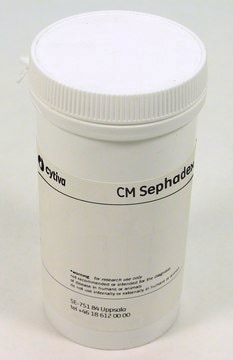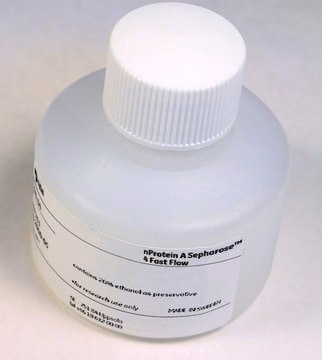GE17-0618-05
Protein G Sepharose™ 4 Fast Flow
Cytiva 17-0618-05, pack of 200 mL
Synonym(s):
Fast Flow resin, Antibody purification resin, IgG purification resin
Sign Into View Organizational & Contract Pricing
All Photos(1)
About This Item
UNSPSC Code:
41106500
NACRES:
NA.56
Recommended Products
ligand
recombinant protein G lacking albumin-binding region
packaging
pack of 200 mL
manufacturer/tradename
Cytiva 17-0618-05
storage condition
(20% Ehtanol)
matrix
4% cross-linked agarose
average diameter
90 μm (d50v)
cleaning in place
2-10
working range
3-9
suitability
suitable for bioprocess medium
storage temp.
2-8°C
General description
Protein G Sepharose™ 4 Fast Flow is recombinant protein G coupled to Sepharose™ 4 Fast Flow.
Protein G Sepharose™ 4 Fast Flow has recombinant protein G immobilized by the cyanogen bromide (CNBr) method to Sepharose™ 4 Fast Flow. Protein G exhibit binding specificities that complement Protein A media and binds to the Fc region of IgG from a variety of mammalian species. Protein G Sepharose™ 4 Fast Flow may be used to isolate and purify classes, subclasses and fragments of immunoglobulins from any biological fluid or cell culture medium.
As member of the BioProcess media range, Protein G Sepharose™ 4 Fast Flow meets industrial demands with security of supply and comprehensive technical and regulatory support.
Protein G Sepharose™ 4 Fast Flow has recombinant protein G immobilized by the cyanogen bromide (CNBr) method to Sepharose™ 4 Fast Flow. Protein G exhibit binding specificities that complement Protein A media and binds to the Fc region of IgG from a variety of mammalian species. Protein G Sepharose™ 4 Fast Flow may be used to isolate and purify classes, subclasses and fragments of immunoglobulins from any biological fluid or cell culture medium.
As member of the BioProcess media range, Protein G Sepharose™ 4 Fast Flow meets industrial demands with security of supply and comprehensive technical and regulatory support.
Features and Benefits
- Binding specificities that complement Protein A media.
- Binds a broad range of IgG species and subclasses.
- Multi-point attachment minimizes ligand leakage.
- Used in a range of research applications.
Storage and Stability
Please be aware this product may be shipped 90 days before the expiration date. For more information on the batch specific expiration date, please contact technical service.
Analysis Note
To view the Certificate of Analysis for this product, please visit www.cytiva.com.
Legal Information
Sepharose is a trademark of Cytiva
Signal Word
Warning
Hazard Statements
Precautionary Statements
Storage Class Code
3 - Flammable liquids
Certificates of Analysis (COA)
Search for Certificates of Analysis (COA) by entering the products Lot/Batch Number. Lot and Batch Numbers can be found on a product’s label following the words ‘Lot’ or ‘Batch’.
Already Own This Product?
Find documentation for the products that you have recently purchased in the Document Library.
Customers Also Viewed
Neutralizing Autoantibodies to Type I Interferons in COVID-19 Convalescent Donor Plasma.
Sara E Vazquez et al.
Journal of clinical immunology, 41(6), 1169-1171 (2021-05-20)
Kanika Vanshylla et al.
Cell host & microbe, 29(6), 917-929 (2021-05-14)
Understanding antibody-based SARS-CoV-2 immunity is critical for overcoming the COVID-19 pandemic and informing vaccination strategies. We evaluated SARS-CoV-2 antibody dynamics over 10 months in 963 individuals who predominantly experienced mild COVID-19. Investigating 2,146 samples, we initially detected SARS-CoV-2 antibodies in 94.4%
Monique G P van der Wijst et al.
bioRxiv : the preprint server for biology (2021-03-25)
Type I interferon (IFN-I) neutralizing autoantibodies have been found in some critical COVID-19 patients; however, their prevalence and longitudinal dynamics across the disease severity scale, and functional effects on circulating leukocytes remain unknown. Here, in 284 COVID-19 patients, we found
Kanika Vanshylla et al.
Cell host & microbe, 30(1), 69-82 (2022-01-02)
A fraction of COVID-19 convalescent individuals mount a potent antibody response to SARS-CoV-2 with cross-reactivity to SARS-CoV-1. To uncover their humoral response in detail, we performed single B cell analysis from 10 SARS-CoV-2 elite neutralizers. We isolated and analyzed 126
Caleigh Mandel-Brehm et al.
Annals of neurology, 92(2), 279-291 (2022-04-26)
Rapid-onset Obesity with Hypothalamic Dysfunction, Hypoventilation and Autonomic Dysregulation (ROHHAD), is a severe pediatric disorder of uncertain etiology resulting in hypothalamic dysfunction and frequent sudden death. Frequent co-occurrence of neuroblastic tumors have fueled suspicion of an autoimmune paraneoplastic neurological syndrome
Our team of scientists has experience in all areas of research including Life Science, Material Science, Chemical Synthesis, Chromatography, Analytical and many others.
Contact Technical Service










